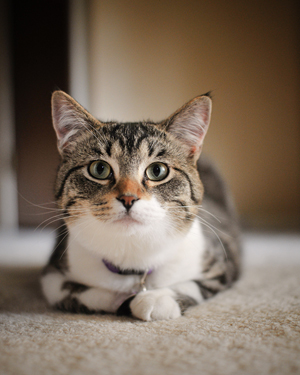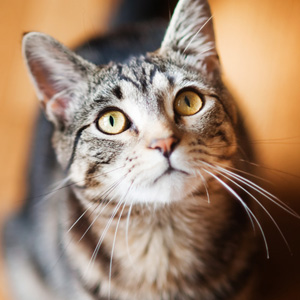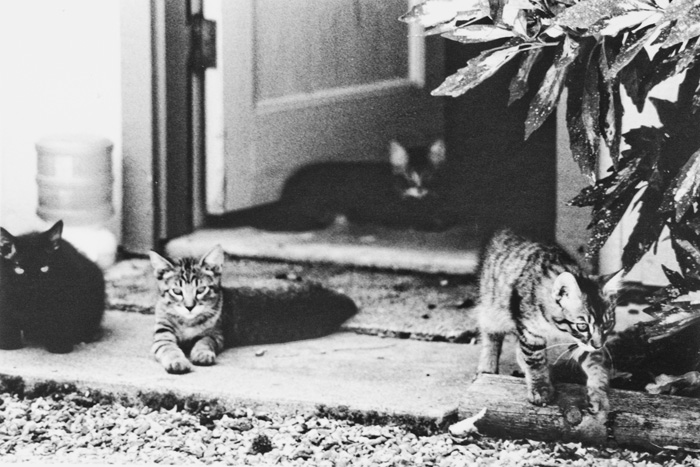Socialize
Animals (okay, cats!) are among my favorite things to photograph. I grew up with cats and each era of my life is accounted for based on what cat was in my life at the time.* So, naturally, as soon as I started picking up the camera in high school our furry friends were my usual subjects. Plus, it’s just so much fun to be able to say you shoot animals and get away with it!
Here are a few photography tips I’ve implemented into my routine whenever I’m trying to get “the shot.”
1. Get down to their level
 Sometimes that shot where Princess is looking up at you all sweet and innocent like is a good thing, but most of the time I try to get down and see eye-to-eye with animals.
Sometimes that shot where Princess is looking up at you all sweet and innocent like is a good thing, but most of the time I try to get down and see eye-to-eye with animals.
It helps make for more interesting angles, since the majority of people take pictures of their pets from their own perspective. It also serves as a natural portal into their lives, and gives you the chance to catch the unique details of your pet, such as their paws, ragged ears or shape and size.
This is a portrait of Sally’s cat, one of the owners of Broadway Books (Sally… not the cat. Though I’m sure Howie has plenty of sage-like business advice, if only he could talk!). Howie had no problem posing for the camera every time I got down to his level – the shots where I simply observed him from a Human’s Eye View are considerably less refined (but just as adorable – we love you Howie!).
2. Put yourself in their paws
Shooting from your pet’s perspective can mean much more than just laying on the sidewalk to fire off a few shots. Like I mentioned in #1, you want to create a portal into your pet’s life. Try following them around for a day, seeing what they see and getting a feel for their day-to-day life. Do they have a favorite place to hang out? Are they friends with other animals? Answering questions like these with your camera will inevitably capture special moments.
For example, when we lived at the Tree House in Arcata and a brief intermission in Redding, Felix was an outdoor cat and wasn’t in the house very often. Sometimes I’d be inside making dinner or watching TV and I’d try to imagine what sort of trouble he was getting into, so I’d grab my camera and go investigate. Often times I’d find him being stealthy in the grass, clambering around on the wooden fence or rubbing his face in our room mate’s catnip plant.
3. Go low, but not too low
 Fellow bokeh junkies can understand the appeal of opening up your aperture to decrease your depth-of-field, but there is such a thing as too wide.
Fellow bokeh junkies can understand the appeal of opening up your aperture to decrease your depth-of-field, but there is such a thing as too wide.
It took me a good 2 years to actually start to understand the disadvantage of shooting at 1.8 all the time, but I really started to grasp it when we got Felix.
Usually you’ll want to get the majority of your pet’s face in focus, and with an aperture of 1.8 you’ll likely get one eye in focus, or the nose and none of the eyes, etc. Experiment with stopping down to f/2.8 or even f/3.5, depending on how long your subject’s face is– you’ll still get some bokeh and your fur ball’s face will be in focus.
4. Your lens cap is your best friend
When I’m walking around the neighborhood hunting for cats to shoot (heehee!), I’ve always got my camera in one hand and my lens cap in the other. It’s like the equivalent of shaking a squeak toy at a baby in a JCPenney photo studio: cats cannot resist the sound of your lens cap squeaking as you pinch the hinges over and over.
Well, most cats, anyway– I have come across a few aloof felines who would rather lick their butts than investigate what obnoxious sound I’m making.
5. Let them be
 Try to avoid getting up in their business, and instead take pictures from a distance so Princess is undisturbed by your perpetual snapping.
Try to avoid getting up in their business, and instead take pictures from a distance so Princess is undisturbed by your perpetual snapping.
Especially when I come across an extra-friendly kitty, the second they see me they’re glued to my legs, making it pretty hard to get a decent photo of them. The same can be said of a skittish cat that’s easily spooked by the sight of a person or the sound of a shutter.
The above photo is from a summer when my MIL’s backyard was inhabited by a litter of feral kittens. They were so adorable to watch, but would scatter the second you crossed their invisible boundary. I parked myself in a lawn chair with a film SLR and 135mm lens to get this shot.
If you can, invest in a lens with some length to it so you can do some stealth-photography while they nap, roll around in the sun or take a bath. On most dSLRs, a 50mm lens actually reaches 75mm, and an 85mm lens is nearly 130mm.
This is sort of the opposite of #2, but it’s good to take a variety of approaches so you end up with a variety of shots. Remember, rules were made to be broken!
Now get out there and shoot some animals! :)
* Childhood: Kismet; Adolescence: Runtimus & Picasso; High school & Junior College: Pierre; Pre-get my life together: Rupee; College: Felix; Currently: Felix & Franny. :)



Hey Kimmy! This is a great post, and is hilarious because I have a 13 year old cat named Princess…! (My mom named her.)